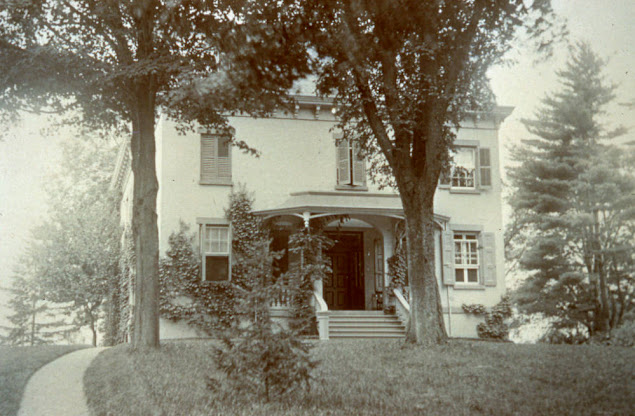Murray Hill: Eccentric Wendel family's wealth linked to the much more illustrious Astors
Meet Irvington's "Weird Wendels," a moniker the Manhattan-based real estate moguls earned during their 19th century heyday.
An 1881 map of Irvington shows the 31-acre summer estate of the fabulously wealthy and infamously Scrooge-like Wendel family stretching over 11 acres between today’s Dows Lane and Clinton Avenue at 100 South Broadway between Broadway and the Old Croton Aqueduct as well as 20 acres east across Broadway.
The estate’s original Victorian main house no longer exists, but a 1930s mansion on about 10 acres of land fronted by the historic Odell Tavern remains on the west half of the original estate bordered by the Aqueduct across Dows Lane from Memorial Park. The old tavern doubled as a gatehouse for the estate and home for the estate's superintendents and their families.
 |
| This is a side view, ca. 1933, of the Odell Tavern which fronts the former Wendel estate at 100 South Broadway. (Library of Congress) |
The Odell Tavern is Irvington’s — and possibly Westchester’s — oldest structure, built in 1693 by Dutch Captain Jan Harmse as a farmhouse on his 563-acre tenant farm on Philipsburg Manor. He was one of four tenant farmers on Philipsburg Manor whose farms now comprise the Village of Irvington. The others were Captain John Buckhout, Wolfert Ecker and Barent Dutcher.
The four farmers purchased their farms outright after the rebellious State of New York seized the Philipse estate to punish its owner, Frederick Philipse III, for his loyalty to the British crown during the American Revolution.
In 1742, Mathius and Sophia Conklin turned the Harmse farmhouse into a tavern on what was then known as King's Highway. King’s Highway was renamed Albany Post Road after independence was declared and finally became known as Broadway or, alternately, U.S. 9.
During the Revolutionary War, owner Col. Jonathan Odell was a well-known Westchester militia leader who would be imprisoned by the British in Sleepy Hollow's Old Dutch Church. At that time, the tavern was located in a 30-mile largely unclaimed band of territory between British forces in New York City to the south and Continental Army forces to the north.
The tavern building is not open to the public, nor is the barn on the property that dates to about 1800.
 |
| This is a 1910 view of the Wendel estate looking northwest from South Broadway. The estate's gazebo is at left, the main mansion at right. (Irvington Public Library, Local History Collection) |
The Wendel family’s roots trace to German immigrant Johann Gottlieb Wendel (1767-1841) who began his career as a fur merchant with partner John Jacob Astor. Wendel married Astor's half-sister, Elizabeth. Like Astor, Wendel invested his profits in Manhattan real estate, building the foundation of what would become an estimated $1.5 billion fortune today.
His son, John D. Wendel, took over his father’s business interests and inherited the family’s Manhattan real estate holdings after Elizabeth Astor Wendel’s death in 1846. John D. and his wife Mary Ann, had eight children — daughters Rebecca, Augusta, Josephine, Henrietta, Georgiana, Mary and Ella and son John Gottlieb Wendell II. Courting was discouraged because John D. did not want to dilute the family fortune via marriage. John D. died in Irvington in October 1876. When Mary Ann died in 1894 she was living with her seven remaining children, all unmarried. John II, later known as "The Hermit of Fifth Avenue," was the new head of household.
Only Rebecca ever married — over John G.’s vehement opposition — and that to a clergyman when she was 61 in 1912. Her brother thereafter reportedly dissuaded his other sisters from attending church to prevent a similar defection.
This photo, c. 1880, has been consistently identified only as a 19th century house in Irvington. However, a comparison with photos of the Wendel mansion c. 1910 shows the same architectural details and it appears almost certainly to be the Wendels' country family home in Irvington viewed from right rear. (Local History Collection, Irvington Public Library)
The Wendel family men were notoriously miserly regarding both themselves and their family members. Their Gilded Age mansion at Fifth Avenue and 39th Street in Manhattan where all the family members lived together, was notably without electricity, telephone or any other modern conveniences, including sewing machines — a notable absence, because the women in the family were forced to repeatedly repair their own Victorian clothing by hand.
The New York Times reported of their Fifth Avenue house: “In winter only the first two floors and the basement are habitable, because the old furnace does not carry heat well above the second floor."
While newspaper society pages were fascinated with the Wendels’ eccentric lifestyle in Manhattan — think of them as the anti-Kardashians — little was written about their lives in Irvington. We do know that John D. and two of his daughters died in Irvington and that the Irvington property was part of the estate left by the last surviving Wendel, Ella, when she died in 1931 without direct heirs.
Much of her $100 million estate ($1.54 billion today) went to charity, but her Irvington estate went to the co-executor of Ella’s will, Isabel Koss Murray. Murray apparently lived there until her death in 1965, renaming the estate “Murray Hill” during her residence.
The existing mansion on the Irvington property was built and occupied by Murray in 1938.
AUTHOR'S NOTE: Tom Miller's blog "Daytonian in Manhattan," which tells the stories of the buildings, statues, etc. that make Manhattan fascinating, was extremely helpful in telling the Wendels' Manhattan story. I highly recommend his story on "The Lost John D. Wendel Mansion."
Another post by Tom Miller regards a property once owned by Mary E.A. Wendel, Ella's sister and daughter of John D. and Mary Ann Wendel: "The Colonel Richard Lathers House, 248 Central Park West."












Comments
Post a Comment
If you would like to weigh-in, feel free ...